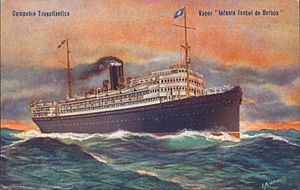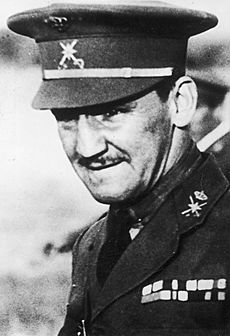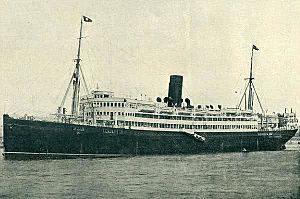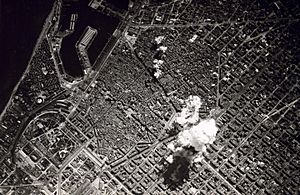SS Infanta Isabel de Borbon facts for kids

1913 postcard of Infanta Isabel de Borbon
|
|
Quick facts for kids History |
|
|---|---|
| Name |
|
| Namesake |
|
| Owner | Compañía Transatlántica Española |
| Operator | |
| Port of registry | Barcelona |
| Route | Barcelona – Buenos Aires |
| Builder | Wm Denny & Bros, Dumbarton |
| Yard number | 969 |
| Launched | 29 September 1912 |
| Completed | 15 March 1913 |
| Maiden voyage | 4 April 1913 |
| Identification | |
| Fate | Sunk by air attack, raised, scrapped |
| General characteristics | |
| Type | ocean liner |
| Tonnage | 10,348 GRT 5,740 NRT |
| Length | 481.9 ft (146.9 m) |
| Beam | 61.3 ft (18.7 m) |
| Draught | 25 ft (7.6 m) |
| Depth | 32.7 ft (10.0 m) |
| Decks | 3 |
| Installed power | 700 NHP |
| Propulsion |
|
| Speed | 17 knots (31 km/h) |
| Capacity |
|
| Sensors and processing systems |
|
| Notes | sister ship: Reina Victoria-Eugenia |
The SS Infanta Isabel de Borbon was a large steamship built in Scotland in 1912. She was an ocean liner, meaning she carried passengers across the ocean, and also a mail ship, carrying letters and packages. She was owned by a Spanish company called Compañía Transatlántica Española (CTE). This ship and her sister ship, the Reina Victoria-Eugenia, were very important because they helped CTE update its fleet of older ships.
In 1931, after Spain became a republic (a country governed by elected officials), the ship's name was changed to Uruguay. In 1932, she was put out of service. Two years later, in 1934, the Spanish government turned her into a prison ship.
During the Spanish Civil War, in 1939, planes from the Nationalist side attacked the Port of Barcelona. The Uruguay was sunk while she was docked there. After the war ended, her wreck was pulled out of the water and taken apart for scrap metal.
Building a Modern Ship
William Denny and Brothers built the Infanta Isabel de Borbon in Dumbarton, Scotland. She was launched into the water on September 29, 1912, and finished on March 15, 1913. At the same time, another company, Swan, Hunter and Wigham Richardson, built her sister ship, Reina Victoria-Eugenia. Even though they were sister ships, they had some important differences in how they were built.
The Infanta Isabel de Borbon's engines were based on a design used for an earlier ship called the Otaki. The Otaki was special because it was the first ship in the world to use a mix of two types of steam engines: reciprocating steam engines and steam turbines.
The Infanta Isabel de Borbon had three screws (the parts that push the ship through the water). The two outer screws were powered by triple-expansion engines. The steam that came out of these engines then went into a single steam turbine in the middle, which powered the third, middle screw. This design was very efficient.
This combination of engines meant the Infanta Isabel de Borbon could move slowly or go backward using only her piston engines. But for faster speeds, she could use her turbine too. This made her more powerful and saved fuel. The total power of her engines was 700 NHP (a way to measure engine power). During her sea trials, which are tests before a ship starts service, she reached a speed of 18.64 knots (about 34.5 kilometers per hour).
The Infanta Isabel de Borbon was designed to carry many passengers. She had space for 100 first-class passengers, 82 second-class passengers, and 1,644 emigrants (people moving to a new country).
The ship also had modern communication tools for its time. She was equipped for wireless telegraphy, which allowed her to send and receive messages using radio waves. She also had submarine signalling, a way to communicate underwater. Her call sign was EDI, which was like her unique radio ID. She was registered in Barcelona, and her code letters were HPBG.
Journeys Across the Ocean
CTE's ships connected Italy and Spain with countries in Latin America. On March 12, 1913, the Reina Victoria-Eugenia began her first journey from Barcelona. She stopped in places like Malaga, Cádiz, Tenerife, and Montevideo before arriving in Buenos Aires. The Infanta Isabel de Borbon started her first journey on April 4, following a similar route.
During the First World War, both the Infanta Isabel de Borbon and Reina Victoria-Eugenia made some trips to New York. For example, on August 26, 1914, the Infanta Isabel de Borbon left Barcelona for New York. All her available spots were filled with American citizens returning home because the war had just started. However, their main job was still to sail between Spain and the Río de la Plata region in South America.
After the war, the two ships went back to their regular routes between Spain and the Río de la Plata. For a while, their route was changed to include stops in Almería and Rio de Janeiro.
These two ships were CTE's most important passenger liners until the company built newer, larger ships in the 1920s.
By 1926, the Infanta Isabel de Borbon had new technology called wireless direction finding. This helped her figure out her position using radio signals. In 1931, when Spain became the Second Spanish Republic, the government decided to rename ships that had been named after members of the Spanish royal family. So, Infanta Isabel de Borbon became Uruguay, and Reina Victoria-Eugenia became Argentina.
Life as a Prison Ship
The Spanish government used to pay CTE to provide mail service between Spain, Uruguay, and Argentina. In 1932, the new government stopped this payment. Because of this, CTE stopped the service on May 8 and put both the Argentina and Uruguay out of service in Barcelona.
By 1934, the Uruguay's old communication codes were replaced with a new call sign, EAFG. Also in 1934, the government took over the Uruguay and used her as a prison ship.

Both the Argentina and Uruguay were still in Barcelona when the Spanish Civil War started in July 1936. On August 11, a Nationalist general named Manuel Goded was captured by the Republicans. His forces had tried to take control of Barcelona. Goded was briefly held prisoner aboard the Uruguay. The very next day, he was put on trial for treason (betraying his country) and was executed by a firing squad.
In January 1939, Nationalist troops were getting close to Barcelona, and their air force bombed the city. Nationalist air raids damaged the Argentina starting on January 16. On January 23, both ships were hit, and the Uruguay sank while she was still tied up at the dock.
Barcelona fell to the Nationalists on January 26, and the Second Republic surrendered on April 1. After the war, the Nationalists pulled the Uruguay's sunken wreck out of the water. She was then taken apart for scrap metal. Sources disagree on the exact dates, but she was likely raised in 1939 or 1940 and scrapped by 1942.
See also
 In Spanish: Uruguay (1933) para niños
In Spanish: Uruguay (1933) para niños



